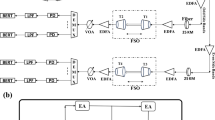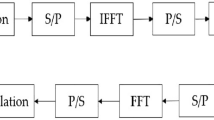Abstract
This work is aimed at providing a novel design of the Visible Light Communication (VLC) system that uses the Multi-Carrier Code-Division Multiple Access (MC-CDMA) technique to send and receive data through intensity-modulated/direct detected (IM/DD) VLC channel. The state-of-the-art framework of Enhanced Sub-Carrier Index Modulation (ESIM) is utilized to reduce the inherent peak-to-average power ratio (PAPR) in Orthogonal Frequency Division Multiplexing. Additionally, the use of cyclic prefix is omitted through the Discrete Wavelet Transform in the current system. Hence, the performance of the system is optimized in terms of PAPR, Bit Error Rate (BER), and data rate. The work presents the closed-form BER expressions for both conventional and proposed techniques in line-of-sight VLC channel. Correspondingly, the simulation programs are also executed to compared the proposed ESIM based WT-MC-CDMA system with both existing systems followed by an analysis of the results. Simulation results show the superior performance of the proposed system compared to existing systems.













Similar content being viewed by others
References
Mumtaz, S., Bo, A., Al-Dulaimi, A., & Tsang, K. F. (2018). Guest editorial 5G and beyond mobile technologies and applications for industrial IoT (IIoT). IEEE Transactions on Industrial Informatics, 14(6), 2588–2591.
Sharma, B., Saini, R. K., Singh, A., & Singh, K. K. (2020). Deep reinforcement learning for wireless network. Machine Learning and Cognitive Computing for Mobile Communications and Wireless Networks., 17, 51–71.
Yan, P., Choudhury, S., Al-Turjman, F., & Al-Oqily, I. (2020). An energy-efficient topology control algorithm for optimizing the lifetime of wireless ad-hoc IoT networks in 5G and B5G. Computer Communications, 159, 83–96.
Tabrizi, H. O., & Al-Turjman, F. (2020). AI for dynamic packet size optimization of batteryless IoT nodes: A case study for wireless body area sensor networks. Neural Computing and Applications, 7, 1–2.
Saadi, M., & Wuttisittikulkij, L. (2019). Visible light communication-the journey so far. Journal of Optical Communications, 40(4), 447–453.
O’Brien, D., Parry, G., & Stavrinou, P. (2007). Optical hotspots speed up the wireless communication. Nature Photonics, 1(5), 245.
Randel, S., Sierra, A., Mumtaz, S., Tulino, A., Ryf, R., Winzer, P. J., Schmidt, C., & Essiambre, R. J. (2012). Adaptive MIMO signal processing for mode-division multiplexing. In OFC/NFOEC. IEEE (pp. 1–3).
Ma, J., Li, K., Tan, L., Yu, S., & Cao, Y. (2016). Exact error rate analysis of free-space optical communications with spatial diversity over gamma-gamma atmospheric turbulence. Journal of Modern Optics, 63(3), 252–260.
Niaz, M. T., Imdad, F., Kim, S., & Kim, H. S. (2016). Deployment methods of visible light communication lights for energy-efficient buildings. Optical Engineering, 55(10), 106113.
Wang, C. X., Haider, F., Gao, X., You, X. H., Yang, Y., Yuan, D., et al. (2014). Cellular architecture and key technologies for 5G wireless communication networks. IEEE Communications Magazine, 52(2), 122–130.
Qiu, Y., Chen, S., Chen, H. H., & Meng, W. (2017). Visible light communications based on CDMA technology. IEEE Wireless Communications, 25(2), 178–185.
Shoreh, M. H., Fallahpour, A., & Salehi, J. A. (2015). Design concepts and performance analysis of multicarrier CDMA for indoor visible light communications. Journal of Optical Communications and Networking, 7(6), 554–562.
McCormick, A. C., & Al-Susa, E. (2002). Multicarrier CDMA for future generation mobile communication. Electronics and Communication Engineering Journal, 14(2), 52–60.
Liao, H., Zhou, Z., Zhao, X., Zhang, L., Mumtaz, S., Jolfaei, A., et al. (2019). Learning-based context-aware resource allocation for edge-computing-empowered industrial IoT. IEEE Internet of Things Journal, 7(5), 4260–4277.
Priyanjali, K. S., & Ramanjaneyulu, B. S. (2017). Performance of MC-CDMA system with various orthogonal spreading codes in a multipath Rayleigh fading channel. In: International conference on smart technologies and management for computing, communication, controls, energy, and materials (ICSTM), IEEE (pp. 309–312).
Soundararajan, R., Kumar, S. R., Gayathri, N., & Al-Turjman, F. (2020). Skyline query optimization for preferable product selection and recommendation system. Wireless Personal Communications., 18, 1–8.
Kondo, S., & Milstein, B. (1996). Performance of multicarrier DS CDMA systems. IEEE Transactions on Communications, 44(2), 238–246.
Taher, M., Singh, M., Ismail, M., Samad, S. A., & Islam, M. T. (2013). Sliding the SLM-technique to reduce the non-linear distortion in OFDM systems. Elektronika ir Elektrotechnika, 19(5), 103–111.
Bolcskei, H., Duhamel, P., & Hleiss, R. (2001). A subspace-based approach to blind channel identification in pulse shaping OFDM/OQAM systems. IEEE Transactions on Signal Processing, 49(7), 1594–1598.
Yu, J. L., & Chen, C. H. (2008). A low-complexity block linear smoothing channel estimation for SIMO-OFDM systems without cyclic prefix. IEICE Transactions on Communications, 91(4), 1076–1083.
Meng, Y., Wang, J., Zhu, J., & Wang, H. (2008). Blind multiuser detection using the subspace-based linearly constrained LSCMA. Signal Processing, 88(9), 2246–2253.
Wu, X., Yin, Q., Zhang, H., & Deng, K. (2002). Time-domain multiuser detection for MC-CDMA systems without cyclic prefix. In International conference on communications, ICC 2002, IEEE (vol. 2, pp. 921–925).
Daly, D., Heneghan, C., & Fagan, A. D. (2004). Minimum mean-squared error impulse response shortening for discrete multitone transceivers. IEEE Transactions on Signal Processing, 52(1), 301–306.
Jones, A. E., Wilkinson, T. A., & Barton, S. (1994). Block coding scheme for reduction of peak to mean envelope power ratio of multicarrier transmission schemes. Electronics Letters, 30(25), 2098–2099.
Saeedi, H., Sharif, M., & Marvasti, F. (2002). Clipping noise cancellation in OFDM systems using oversampled signal reconstruction. IEEE Communications Letters, 6(2), 73–75.
Muller, S. H., & Huber, J. B. (1997). OFDM with reduced peak-to-average power ratio by optimum combination of partial transmit sequences. Electronics Letters, 33(5), 368–369.
Bauml, R. W., Fischer, R. F., & Huber, J. B. (1996). Reducing the peak-to-average power ratio of multicarrier modulation by selected mapping. Electronics Letters, 32(22), 2056–2057.
Zhang, H., Zhang, J., & Qiu, K. (2014). Performance comparison of wavelet packet transform-based and conventional coherent optical OFDM transmission system. Optik, 125(11), 2647–2651.
Ahsan, M., & Asif, H. M. (2017). ESIM-OFDM-based transceiver design of a visible light communication system. International Journal of Communication Systems, 30(8), e3175.
Dang, J., Wu, L., & Zhang, Z. (2017). OFDM systems for optical communication with intensity modulation and direct detection. Optical Fiber and Wireless Communications, 85, 111–117.
Dissanayake, S. D., & Armstrong, J. (2013). Comparison of ACO-OFDM, DCO-OFDM and ADO-OFDM in IM/DD systems. Journal of Lightwave Technology, 31(7), 1063–1072.
Khalid, A., & Asif, H. M. (2018). OCDMA and OSTBC based VLC transceiver design using NI cDAQ. Photonic Network Communications, 35(1), 97–108.
Burrus, C. S., Gopinath, R. A., Guo, H., Odegard, J. E., & Selesnick, I. W. (1998). Introduction to wavelets and wavelet transforms: A primer (p. 1). New Jersey: Prentice Hall.
Lakshmanan, M. K., & Nikookar, H. (2006). A review of wavelets for digital wireless communication. Wireless Personal Communications, 37(3–4), 387–420.
Kaiser, G. (2010). A friendly guide to wavelets. Berlin: Springer Science & Business Media.
Polikar, R. (1998). Multi-resolution analysis: The discrete wavelet transform, the wavelet tutorial part IV. Rowan University, College of Engineering Web Servers (p. 10).
Baig, S., Asif, H. M., Umer, T., Mumtaz, S., Shafiq, M., & Choi, J. G. (2018). High data rate discrete wavelet transform-based PLC-VLC design for 5G communication systems. IEEE Access, 6, 52490–52499.
Li, A., Shieh, W., & Tucker, R. S. (2010). Wavelet packet transform-based OFDM for optical communications. Journal of Lightwave Technology., 28(24), 3519–3528.
Guillen, D., Idarraga-Ospina, G., & Cortes, C. (2016). A new adaptive mother wavelet for electromagnetic transient analysis. Journal of Electrical Engineering, 67(1), 48–55.
Khan, A., Arif, A., Nawaz, T., & Baig, S. (2017). Walsh Hadamard transform based transceiver design for SC-FDMA with discrete wavelet transform. China Communications, 14(5), 193–206.
Chvojka, P., Zvanovec, S., Haigh, P. A., & Ghassemlooy, Z. (2015). Channel characteristics of visible light communications within a dynamic indoor environment. Journal of Lightwave Technology, 33(9), 1719–1725.
Pesek, P., Zvanovec, S., Chvojka, P., Bhatnagar, M. R., Ghassemlooy, Z., & Saxena, P. (2018). Mobile user connectivity in relay-assisted visible light communications. Sensors, 18(4), 1125.
Komine, T., & Nakagawa, M. (2004). Fundamental analysis for a visible-light communication system using LED lights. IEEE Transactions on Consumer Electronics, 50(1), 100–107.
Lee, K., Park, H., & Barry, J. R. (2011). Indoor channel characteristics for visible light communications. IEEE Communications Letters, 15(2), 217–219.
Vitthaladevuni, P. K., Alouini, M.-S., & Kieffer, J. C. (2005). Exact BER computation for cross QAM constellations. IEEE Transactions of Wireless Communication, 4(6), 3039–3050.
Alouini, M. S., & Goldsmith, A. J. (1999). A unified approach for calculating error rates of linearly modulated signals over generalized fading channels. IEEE Transactions on Communications, 47(9), 1324–1334.
Tsonev, D., Sinanovic, S., & Haas, H. (2011). Enhanced subcarrier index modulation (SIM) OFDM. In GLOBECOM workshops (GC Wkshps), IEEE (pp. 728–732).
He, Q., Schmitz, C., & Schmeink, A. (2013). BER of Fourier transform and discrete wavelet transform based OFDM, ISWCS 2013. In The tenth international symposium on wireless communication systems, Ilmenau, Germany (pp. 1–5).
OptoSupply, OSW4XME3C1S LED. (2012). https://www.alldatasheet.net/datasheet-pdf/pdf/352547/OPTOSUPPLY/OSW4XME3C1S.html.
Hamamatsu Photon, Si PIN Photodiode—S6775. (2014). https://www.hamamatsu.com/resources/pdf/ssd/s2506-02-etc-kpin1048e.pdf.
Musabe, R., Lionel, M. B., Ushindi, V. M., Atupenda, M., Ntaganda, J., & Bajpai, G. (2019). PAPR reduction in LTE network using both peak windowing and clipping techniques. Journal of Electrical Systems and Information Technology, 6(1), 3.
Author information
Authors and Affiliations
Corresponding author
Ethics declarations
Conflict of interest
The author(s) declare(s) that there is no conflict of interest regarding the publication of this paper.
Additional information
Publisher's Note
Springer Nature remains neutral with regard to jurisdictional claims in published maps and institutional affiliations.
Rights and permissions
About this article
Cite this article
Khalid, A., Rashid, F., Tahir, U. et al. Multi-carrier Visible Light Communication System Using Enhanced Sub-carrier Index Modulation and Discrete Wavelet Transform. Wireless Pers Commun 127, 187–215 (2022). https://doi.org/10.1007/s11277-021-08121-y
Accepted:
Published:
Issue Date:
DOI: https://doi.org/10.1007/s11277-021-08121-y




